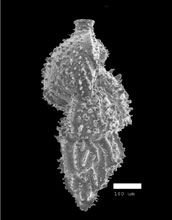Multimedia Gallery
Microscopic Sea Animals (Image 2)
Microscopic Sea Animals (Image 2)
Species Angulogerina pauperata, a benthic (lives on the bottom of the ocean) Antarctic foraminifera. This organism produces a test (shell) made of calcium carbonate (CaCO3).
These fossilized foraminifera (one-celled sea creatures with tiny shells) were collected from sediment cores from Antarctica. The cores were drilled in areas of the sea floor that until recently were covered by the Larsen Ice Shelf. By knowing what environmental conditions are required by living species of forams, scientists can tell what conditions prevailed in the region when the fossilized specimens were alive. The specimens were collected and photographed using a scanning electron micrograph (SEM) by Scott Ishman, a paleobiologist and assistant professor of geology at Southern Illinois University, Carbondale, and Scott McCallum, a master's student working with Ishman.
The National Science Foundation provided funding for the SEM images and the collection of data. (Date of Image: May 2003) [One of several related images. See Next Image.]
Credit: Images by Scott McCallum and Scott Ishman
Images and other media in the National Science Foundation Multimedia Gallery are available for use in print and electronic material by NSF employees, members of the media, university staff, teachers and the general public. All media in the gallery are intended for personal, educational and nonprofit/non-commercial use only.
Images credited to the National Science Foundation, a federal agency, are in the public domain. The images were created by employees of the United States Government as part of their official duties or prepared by contractors as "works for hire" for NSF. You may freely use NSF-credited images and, at your discretion, credit NSF with a "Courtesy: National Science Foundation" notation.
Additional information about general usage can be found in Conditions.
Also Available:
Download the high-resolution JPG version of the image. (176 KB)
Use your mouse to right-click (Mac users may need to Ctrl-click) the link above and choose the option that will save the file or target to your computer.



